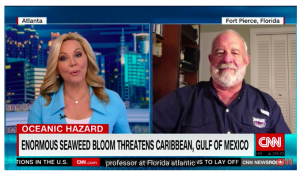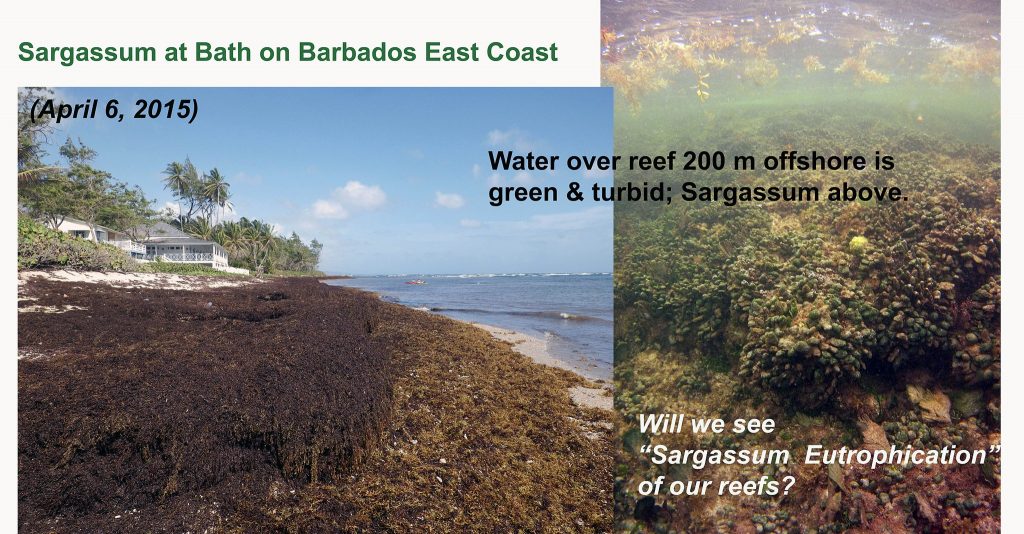UPDATE May 3, 2023
Strange sighting among sargassum seaweed
YouTube Video uploaded May 2, 2023. by Caribbean Broadcasting Corporation
——-
ORIGINAL POST
“A blob twice the width of the US is heading towards Florida’s coast” So reads the title of a March 15, 2023 YouTube video in which  CNN’s Rosemary Church interviews a leading scientist about a 5,000-mile-wide stinky seaweed blob that’s headed for Florida beaches in the coming months. In the video, Barbados is cited as a place where recently 1600 dump truck-full loads a day were being taken from beaches.
CNN’s Rosemary Church interviews a leading scientist about a 5,000-mile-wide stinky seaweed blob that’s headed for Florida beaches in the coming months. In the video, Barbados is cited as a place where recently 1600 dump truck-full loads a day were being taken from beaches.
My first encounter with masses of Sargassum was at Bath in 2015:

Recent in the News:
Seaweed causing significant beach erosion
Article in Barbados Today, Mar 10, 2023. “Permanent Secretary in the Blue Economy Division of the Ministry of Environment and National Beautification Sonia Foster informed today’s opening session of the Third University of the West Indies Sargassum Symposium of the stress being placed on the island’s east and south coast beaches during the appearance of the seaweed from the January to September.”
Read more about the Sargassum issue at the Sargassum Hub.
For medium-range (3-monthly) island-scale forecasts of sargassum influxes to the Eastern Caribbean, see the Sargassum Outlook Bulletin.
This recent scientific article provides some insights to what’s behind the blooms:
Physical drivers of pelagic sargassum bloom interannual variability in the Central West Atlantic over 2010–2020
Nikolaos Skliris et al., 2021 in Nature.
Abstract (bolding inserted)
Since 2011, unprecedented pelagic sargassum seaweed blooms have occurred across the tropical North Atlantic, with severe socioeconomic impacts for coastal populations. To investigate the role of physical drivers in post-2010 sargassum blooms in the Central West Atlantic (CWA), conditions are examined across the wider tropical North Atlantic, using ocean and atmospheric re-analyses and satellite-derived datasets. Of particular consequence for the growth and drift of sargassum are patterns and seasonality of winds and currents. Results suggest that in years of exceptionally large sargassum blooms (2015, 2018), the Intertropical Convergence Zone (ITCZ), an area of maximum wind convergence where sargassum naturally accumulates, shifted southward, towards nutrient-rich waters of the Amazon River plume and the equatorial upwelling zone further stimulating sargassum growth. These changes are associated with modes of natural variability in the tropical Atlantic, notably a negative phase of the Atlantic Meridional Mode (AMM) in 2015 and 2018, and a positive phase of the Atlantic Niño in 2018. Negative AMM in these 2 years is also associated with stronger trade winds and enhanced northwest Africa upwelling, probably resulting in stronger southwestward nutrient transport into the eastern part of CWA. Moreover, in contrast with most years, important secondary winter blooms took place in both 2015 and 2018 in the northern part of CWA, associated with excessive wind-driven equatorial upwelling and anomalously strong northwestward nutrient transport.
The Amazon has become increasingly nutrient-rich as forests in the Amazon watershed are cut down (releasing nutrients) and replaced by plantations (with highly soluble nutrients – especially nitrogen added in the form of fertilizers). Increased flooding associated with climatic change is likely also involved.* So unless there are massive changes in the management of forests in that area, it seems we are stuck with Sargassum blooms for the foreseeable future.
_______
*”Such increases in nutrient fluxes could be partially due to Amazonian deforestation (+25% since 2010), which has been shown to alter the hydrochemical balance of streams and soil chemistry. In addition, extreme flooding events in the Amazon basin in this time frame58 combined with increased fertilizer use (+67% since 2010)15 could also contribute” – From LaPointe et al., 2021 (see below).
One “solution” discussed in the video is to harvest the blooms before they reach land and sink them in the deep ocean. This could act as a significant carbon-dioxide trap, helping us to reduce global warming.
As has been oft said: We’re all connected.
Some Scientific Lit.
Identification of Amazon River water at Barbados, West Indies, by salinity and silicate measurements.
Steven, D. M. and A. L. Brooks. 1972. Mar. Biol., 14, 345-348.
Influence of Amazon River discharge on the marine production system off Barbados, West Indies
R Kidd, F Sander – Journal of Marine Research, 1979
Comment: David Stevens was a McGill Prof who worked out of the Bellairs Research Institute when I and Finn Sanders were grad students there back in the latter 1960s. Finn initiated his PhD research with Prof. Steven as supervisor (Prof Steven died before Finn completed his PhD). Finn went on to become director of Bellairs after Bellairs founder and first director J.B. Lewis retired from the position. Finn & Co. and wrote several key papers on nutrient enrichment in the area of Barbados. I remember at the time (1960s) that the concept of the Amazon River so far away influencing the water chemistry at Barbados seemed remarkable. In my PhD research at Barbados, I was trying to explain how turtle grass (a seagrass, Thalassia testudinum) was so productive in such apparently nutrient-poor waters. Now flash forward 50 years, and what we are looking at is massive oceanic nutrient enrichment originating in the Amazon affecting Barbados…, that was certainly not anticipated in those days. How the natural world has changed so much in such a short time.
Nutrient content and stoichiometry of pelagic Sargassum reflects increasing nitrogen availability in the Atlantic Basin
B. E. Lapointe et al., 2021 in Nature
Abstract The pelagic brown macroalgae Sargassum spp. have grown for centuries in oligotrophic waters of the North Atlantic Ocean supported by natural nutrient sources, such as excretions from associated fishes and invertebrates, upwelling, and N2 fixation. Using a unique historical baseline, we show that since the 1980s the tissue %N of Sargassum spp. has increased by 35%, while %P has decreased by 44%, resulting in a 111% increase in the N:P ratio (13:1 to 28:1) and increased P limitation. The highest %N and δ15N values occurred in coastal waters influenced by N-rich terrestrial runoff, while lower C:N and C:P ratios occurred in winter and spring during peak river discharges. These findings suggest that increased N availability is supporting blooms of Sargassum and turning a critical nursery habitat into harmful algal blooms with catastrophic impacts on coastal ecosystems, economies, and human health.
Influence of the Amazon-Orinoco Discharge Interannual Variability on the Western Tropical Atlantic Salinity and Temperature
M. Gévaudan et al. 2022. In JGR OceansPDF
The great Atlantic Sargassum belt
Wang et al., in Science
Page updated/modified Mar 16, 2023
